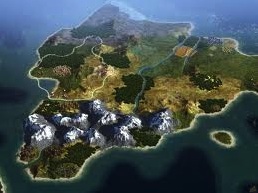
20 Jul EARTH MATTERS: HAWAIIAN AGRICULTURE
Past, Present and Future
 Isolated 2,350 miles from San Francisco on the edge of the Tropic of Cancer between 16 to 20 degrees north latitude, the Big Island of Hawaii has been blessed with the unique synergy of having a mild tropical climate that facilitates high agricultural yields along with seasonal cold fronts normally associated with mid-latitude locations and breathtaking topography.
Isolated 2,350 miles from San Francisco on the edge of the Tropic of Cancer between 16 to 20 degrees north latitude, the Big Island of Hawaii has been blessed with the unique synergy of having a mild tropical climate that facilitates high agricultural yields along with seasonal cold fronts normally associated with mid-latitude locations and breathtaking topography.
According to Margaret Hopkins of the Department of Research and Development at the county of Hawaii:
“The presence of the 11 of the world’s 12 micro-climates on the Big Island provides great opportunity to make our island the center for ‘customized’ farming technology development in the world.”
The topography of the Big Island rises from sea level to the 13,796 summit of Mauna Kea, called Pu’u Wekiu. Thus, the diversity of climate zones on the Big Island supports the growth of nearly every plant species that exists on Earth.
Historically, between the years 500 and 700 C.E., Polynesians from the islands of Marques brought various plant species to Hawaii for food security, cultural value and shelter. Their selection of plants included ‘Ape, ’Awa, ’Awapuhi Kuahiwi (shampoo ginger), Hau Ipu, Kalo (taro), Kamani, Ki, Ko (sugar cane), Kou, Kukui, Mai’a (banana), Niu (coconut), Noni, “Ohe (bamboo), ‘ohi’a ‘Ai (mountain apple), ‘Olena (turmeric), Olana, Pia, Uala (sweet potato), Uhi (yam), ‘Ulu and Wauke.
Between 1859 and 1951, the California gold rush brought an agricultural boom to Hawaii with the introduction of staple crops such as Irish potatoes, onions, oranges, and coffee. This boom was initially spurred by the exportation of hogs to California in 1853, the introduction of rice in 1858, two dairy farms in 1880, and the opening of sugar plantations by Chinese merchants from Honolulu. Rice production peaked around 42 million pounds in 1907 and sugarcane peaked around 1933 with 254,563 acres being planted. Other commodities of note include the introduction of solo papaya in 1911, the swine population peak of 90,000 head in 1945, and the capture of 45% of the world’s Macadamia nut production in 1999.
In the modern era, agricultural production in Hawaii has significantly diminished due to a shift of rice, sugar cane and pineapple production to off-island locations with lower labor and land costs. Compounding the problem, previous Hawaii regulations economically inhibit small-scale local agriculture. As a result, Hawaii currently imports 85% of its food and its residents spend 22% of their income on imported food compared to about 13% paid by “mainland” residents. In 2008, the local market share of production for food staples such as meat, eggs and milk was only 11%. Similarly, locally grown vegetables constituted only 36% of the market share. Conversely the seafood market was nearly 100% locally produced.
In an effort to balance the economy, social issues and protect the environment, the state of Hawaii over time has developed laws to protect and promote agriculture. These types of Federal and State laws pertain to pest control, biological control, water use, waste, zoning, agricultural methods, trade and tariffs. Although some of the laws and regulations add to the cost of agricultural production, they are intended to protect the ability of future generations by creating an adaptive system of sustainability. However, the economic burden of compliance to the local farmers inhibit their ability to compete with imported food products. A potential solution entails creating financial tools and services that help farmers acquire affordable loans or subsidies to compete with imported products. County agencies could also establish zoning regulations such as outlined in the “Right to Farm Act” to preserve the availability of agricultural land for future generations. Furthermore, the creation of taxes on imported food products that are also grown locally could encourage an increase in local agriculture.
Thus, the future of agriculture in Hawaii involves the development of an adaptive management plan that addresses the challenges of the Hawaiian agricultural industry. According to Margaret Hopkins of the Department of Research and Development at the County of Hawaii, the top ten pro-active initiatives for the agricultural industry are:
• Strengthen the implementation of the “right to farm” act.
• Encourage agriculture research by allocating the 1,000-acre piece of land in Paauilo to this purpose.
• Codify rules and regulations that encourage multiple-use on Ag lands. These lands should be sustainable and have minimal impact upon the agricultural nature of the lands.
• Encourage the State Department of Agriculture to offer full services on this island. e.g. inspections in Kona and Hilo for pests etc.
• Encourage adequate funding for extension services.
• Encourage legislation that will require locally grown products to be served in school cafeterias.
• Encourage CTAHR to reconsider changing its emphasis from commodity-based to local-based multi-crop extension agents.
• Encourage legislation that will provide tax credit to eating establishments that serve locally grown products.



Greg Smith
Posted at 00:21h, 11 SeptemberAloha
My name is Greg Smith and I have a farm on the Big Island of Hawaii called Earth Matters just wondered if there is any connection. Like your article about farming in Hawaii.
admin
Posted at 19:47h, 30 SeptemberGreg,
Glad you liked the article. As for the name- just coincidence.